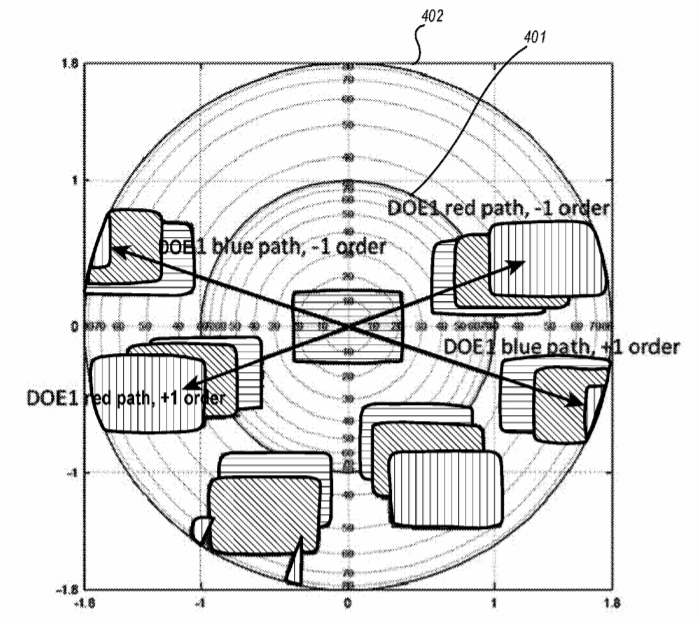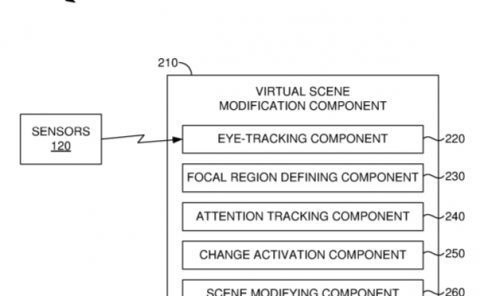Microsoft Patent | Large-Field-of-View Waveguide Supporting Red, Green, and Blue in One Plate
Patent: Large-Field-of-View Waveguide Supporting Red, Green, and Blue in One Plate
Publication Number: 20190004219
Publication Date: 2019-01-03
Applicants: Microsoft

Abstract
An optical device for combining RGB optical signals in a single waveguide. The device includes a plurality of DOEs. A first DOE is configured to receive an optical signal at input propagation angles and to diffract the optical signal based on spectrum such that predominately one spectrum of light is diffracted in a first direction and path and predominately a second spectrum of light is diffracted in a second different direction and path. The first DOE is configured to diffract light into a second DOE. The second DOE is configured to diffract light into a third DOE. The third DOE is configured to diffract light into an eye box keeping output propagation angles substantially parallel to the input propagation angles. A summation of grating vectors for each of the paths is substantially equal to zero.
Background
Recently, there has been a resurgence in the interest in virtual reality (VR) and augmented reality (AR) devices and other such near eye devices. These devices typically include a video transmitter of some sort, such as a light engine, and optics couple to the video transmitter configured to transmit images to the eyes of the user using the devices. In particular, a user will wear a headset or similar device that includes a video transmitter optically coupled to one or more waveguides where the waveguides are configured to optically couple images out to a user.
One problem that has needed to addressing by manufacturers of such devices is a problem related to limited Field of View (FoV). In the contexts illustrated herein, the FoV is the number of degrees of visual high angle assuming a fixed eye position. Horizontally, the FoV for a human is around 135.degree.. However, often virtual reality and augmented reality devices will have a much lower FoV available. The lower the FoV available from the device, the less realistic the experience with the device.
Technologies have been implemented which attempt to widen the FoV. One such technology is the use of diffraction gratings which spread the light by wavelength to increase the FoV. That is, a diffraction grating is dispersive, which means that it creates diffraction orders such that the colors of all non-zero orders propagate in different directions. While this behavior is highly beneficial, e.g., in spectroscopic applications, in AR/VR devices based on diffractive waveguides it is unwanted, since carrying and expanding the image content in the waveguide requires three (or in some cases two) separate waveguides unless the FoV is very small.
Having multiple waveguides greatly complicates the manufacturing process. Not only one must manufacture several waveguides but manufacturing tolerances become much tighter. In addition, one must accurately put the multiple plates in a grating stack, which adds additional manufacturing steps which require high accuracy, and increased cost.
The subject matter claimed herein is not limited to embodiments that solve any disadvantages or that operate only in environments such as those described above. Rather, this background is only provided to illustrate one exemplary technology area where some embodiments described herein may be practiced.
Summary
One embodiment illustrated herein includes an optical device for combining RGB optical signals in a single waveguide. The device includes a plurality of DOEs. The device includes a first DOE configured to receive an optical signal at input propagation angles and to diffract the optical signal based on spectrum such that predominately one spectrum of light is diffracted in a first direction and predominately a second spectrum of light is diffracted in a second different direction such that different portions of optical signal take different paths, including at least two different paths. The device includes a second DOE. The first DOE is configured to diffract light into the second DOE. The device includes a third DOE. The second DOE is further configured to diffract light into the third DOE. The second and third DOE are configured to cause expansions that are substantially non-parallel. The third DOE is configured to diffract light into an eye box keeping output propagation angles within some predetermined threshold of the input propagation angles. The plurality of DOEs are associated with grating vectors. A summation of grating vectors for each of the paths in the at least two different paths is substantially equal to zero.
This Summary is provided to introduce a selection of concepts in a simplified form that are further described below in the Detailed Description. This Summary is not intended to identify key features or essential features of the claimed subject matter, nor is it intended to be used as an aid in determining the scope of the claimed subject matter.
Additional features and advantages will be set forth in the description which follows, and in part will be obvious from the description, or may be learned by the practice of the teachings herein. Features and advantages of the invention may be realized and obtained by means of the instruments and combinations particularly pointed out in the appended claims. Features of the present invention will become more fully apparent from the following description and appended claims, or may be learned by the practice of the invention as set forth hereinafter.



